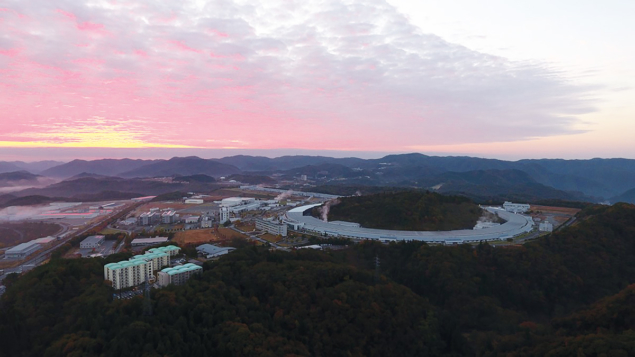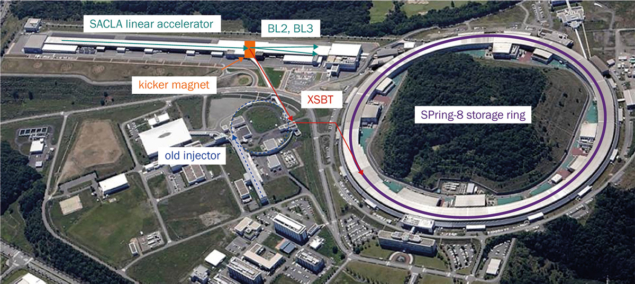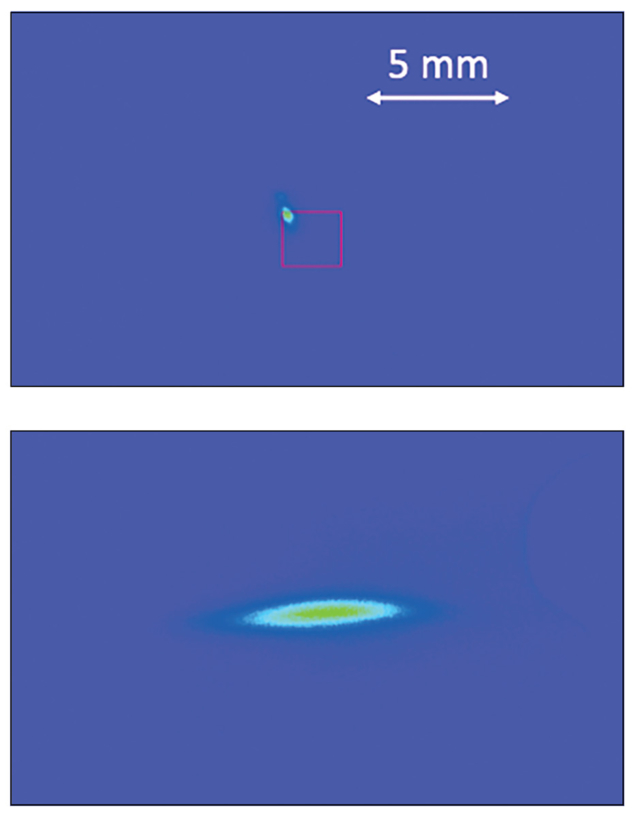In a world-first implementation, the linear accelerator of the SACLA X-ray free-electron laser is now being used as the beam injector for the storage ring of the SPring-8 synchrotron light source. Project leader Toru Hara explains the technical motivations for the upgrade and the long-term operational benefits.

Sometimes, it seems, mere proximity is the engine-room of opportunity. That’s certainly the case for two of Japan’s flagship large-scale research centres – the SPring-8 (Super Photon Ring 8 GeV) synchrotron facility and SACLA (the SPring-8 Angstrom Compact free-electron LAser) – which are co-located adjacent to each other on the main campus of Harima Science Park City in Hyogo Prefecture.
It’s now two years since a joint research group from SPring-8 Center, which is managed by Japan’s premier research agency RIKEN, and the Japan Synchrotron Radiation Research Institute (JASRI), responsible for promoting the use of SPring-8, succeeded in utilising the linear accelerator of the SACLA X-ray free-electron laser (XFEL) facility as an injector for the SPring-8 storage ring.
The upsides were immediate, impressive and – crucially – sustained. For starters, the 25-year-old injector of SPring-8, which hitherto was used exclusively for beam injection, has been superseded by the SACLA linear accelerator – reducing the electricity consumption needed to support SPring-8 operation by roughly 20%. Equally significant, the quality of the electron beam injected into the storage ring has been enhanced markedly – a breakthrough that will underpin the upgrade plan of SPring-8 to a fourth-generation light source (SPring-8-II) capable of generating X-ray beams hundreds of times brighter than the current facility.
Legacy problems, creative solutions
By way of context, the previous, dedicated injector for the SPring-8 storage ring consisted of a 1 GeV linear accelerator and an 8 GeV synchrotron booster. The emittance of the resulting injection beam was about 200 nm-rad, which is far larger than the specification of the future SPring-8-II (at 10 nm-rad). There were legacy technology issues as well: both injector accelerators were more than 25 years old, while the associated (and somewhat decrepit) high-voltage power substation was itself in need of a root-and-branch overhaul.

Cue some creative thinking and the game-changing idea of deploying SACLA’s low-emittance electron beam for SPring-8 beam injection (and in parallel to its core function as a source of XFEL photon beams for front-line research). Herein an engineering win-win began to take shape: on the one hand, the opportunity to decommission (rather than renovate) the high-voltage substation; on the other, to simultaneously reduce SPring-8’s electricity consumption significantly by shutting down the old injector accelerators (which were always maintained in operational mode despite the only intermittent requirement for beam injection). Underpinning it all is the fact that the SACLA linear accelerator is always online for the XFEL research users, so no additional cost or energy consumption accrues when sending a small number of electron-beam pulses from SACLA to the SPring-8 storage ring.
In the early design phase of SACLA (around 2008), and with engineers anticipating the future possibility of beam injection to SPring-8, the nominal beam energy of SACLA was set at 8 GeV to match the SPring-8 storage ring. The direction of the SACLA electron beam was also fixed towards SPring-8 to facilitate the envisaged beam-injection
scenario. To join things up, the two accelerators are linked by a beam transport line – the XFEL to Storage ring Beam Transport (XSBT) – which was constructed at the same time as the SACLA facility (see images “Better together” and “Joined up”).
When it comes to the technical specifics, the SACLA beam repetition rate is set at 60 Hz, with the electron-beam pulses distributed on a pulse-by-pulse basis in three directions with the help of a “kicker” magnet: along two XFEL beamlines (BL2 and BL3) and down the XSBT beamline. What’s more, the electron-beam energies for XFEL user experiments are often adjusted in a range between 5 and 8 GeV depending on laser wavelengths, while the energy needs to be fixed at 8 GeV for the beam injection. It is therefore essential to control the electron-beam parameters pulse-by-pulse to allow XFEL user experiments and the SPring-8 beam injection to proceed in parallel.
Synchronisation is nothing without control
Operationally, the preparation of the SACLA beam-injection scheme took about two years in design, planning and commissioning. The first task for the project team was to synchronise the two accelerators, given that they run on different reference clock frequencies (238 MHz for SACLA; 508 MHz for SPring-8). Since the two frequencies do not have a harmonic relation, the injection timing naturally goes off with respect to the target RF bucket of SPring-8 by a maximum ±2.1 ns. A novel timing system was subsequently developed to provide the necessary synchronisation.

In top-up injection mode, which keeps a constant stored current within the storage ring, SPring-8 sends a beam request to SACLA when the stored current decreases under a certain threshold. Once SACLA receives the request, the timing system first searches out a point where the timing difference is at a minimum. By delaying the beam injection up to 197 µs, there should be a point where the timing difference becomes smaller than 105 ps. In a second step, a slight frequency modulation is applied to the SACLA 238 MHz reference clock, such that SACLA and SPring-8 are finally synchronised to within 3.8 ps (RMS).
Another significant piece of work involved retrofitting the accelerator control system. To change the accelerator parameters pulse-by-pulse, it is necessary for accelerator components to “know” the destination of the next beam pulse. That granular data (at the level of an individual pulse) is therefore sent through a “reflective memory network” to key components and subsystems – for example, RF sources and magnet power supplies – such that these devices can then operate with prestored parameters corresponding to the relevant beam destination.
Meanwhile, all diagnostic data are saved in a database with a pulse tag number so that the measured data, such as beam trajectories and charges, can be distinguished among the three beam destinations (BL2, BL3 and XSBT). It is like there are three accelerators independently running with different beam energies and parameters. In day-to-day operation, three operators adjust and tune the accelerators by looking at the monitor and control panels for the three beams versus the respective destinations. Using the pulse tag number, XFEL users are also able to see which pulses were used for the beam injection, so that these pulses can be eliminated from their experimental data.
A final core deliverable for the project team was to ensure the bulletproof reliability of SACLA – since the storage ring cannot operate without beam injection. In short, if the linear accelerator of SACLA fails to provide electron beams, close to 60 experiments on the SPring-8 beamlines are at risk of grinding to a halt. Redundancy is the key here: to promptly recover from unexpected troubles, the team installed back-up components for crucial accelerator devices, such as the electron gun, kicker magnet and RF sources.
Going live
During the early-stage evaluation of the new beam-injection scheme, two other issues came into play: electron bunch purity and magnetic hysteresis of the kicker magnet. The electron bunch purity is a ratio of electron charges contained in an electron-injected RF bucket and an empty bucket on the storage ring.
It is an important figure of merit – not least for ensuring low background noise in time-resolved experiments. A bunch purity of between 10–8 and 10–10 is typically required at SPring-8, while the electron bunch charge of SACLA is around 200 pC – i.e. even a single electron outside the beam pulse could degrade the bunch purity.

It turned out, however, that a small number of electrons were detected 18 ns after the main beam pulse during the initial experimental runs. After detailed investigation, the project team found that these electrons were slipping out from the main pulse and making a round trip between two RF cavities at the injector section of SACLA. Consequently, they were delayed by 18 ns and being injected into unexpected RF buckets on the storage ring. The solution: remove the delayed electrons using an electric sweeper and an RF knockout system – a breakthrough that, in turn, yielded the required bunch purity of 10–10.
At the far-end of SACLA’s linear accelerator, electron-beam pulses are deflected horizontally in three directions by a kicker magnet. The polarity of the kicker current is negative for BL2, zero for BL3 and positive for XSBT. As a consequence, the beam orbits of the pulses just after the beam injection (i.e. two to three times a minute) deviate from the optimum trajectory inside the XFEL undulators – seriously degrading pointing stability and laser power within the SACLA beamlines. To overcome this issue, the excitation pattern of the kicker magnet is modified slightly after the beam injection, such that the hysteresis effect is now suppressed within an angular deviation of 1 µrad (i.e. less than 10 % of the laser spot size).
With those “issues arising” addressed successfully by the project team, it’s instructive to look at the high-level operational performance of the new beam-injection arrangement. To fill up the storage ring with a nominal stored current of 100 mA, the electron beam is injected at 10 Hz from SACLA. The process takes about 10 minutes – roughly twice as fast as the old injector. Once the storage ring is filled, top-up injection gets underway to keep the stored current at a constant level. In top-up mode, the electron beam is injected typically 2–3 times every minute. Measuring the transverse beam sizes at the injection point of SPring-8 shows that the size of the electron beam from SACLA is significantly narrower versus that from the old injector, with the beam quality represented by emittance improving from 200 nm-rad to 1 nm-rad – more than satisfying the criteria for the future SPring-8-II.
Green machines
Alongside those sustained performance improvements, there are other notable wins to report for the SACLA beam-injection arrangement. After a probation period of six months, the old SPring-8 injector and its power station were shut down in April 2021, yielding a 5 MW saving in electricity consumption and an impressive 20% reduction in the SPring-8 power bill (i.e. versus current SPring-8 plus the old injector).

Further operational efficiencies are in the works for SPring-8-II given the global surge in energy prices and the shared commitment (with SACLA) towards carbon neutrality by 2050. By using cutting-edge, short-period, in-vacuum undulator technologies in SPring-8-II, for example, the electron-beam energy will be reduced from 8 GeV to 6 GeV without changing the X-ray radiation energy range. Replacing accelerator electromagnets with permanent magnets will enable additional reductions in power consumption. The ultimate goal of SPring-8-II, and with user operation pencilled in to begin no later than 2030, is a 50% reduction in power consumption versus the current SPring-8.
The ultimate goal is a 50% reduction in power consumption for SPring-8-II versus the current SPring-8
Similarly ambitious plans are taking shape for the SACLA-II upgrade, which will take place after the completion of SPring-8-II. The end-game: a 1 kHz repetition rate using conventional (rather than superconducting RF) accelerator technologies. With traditional RF acceleration, of course, more than 99.99 % of the input power is dissipated as heat – rather than accelerating the electron beam – so the challenge for SACLA-II is to boost this extremely low conversion efficiency, thereby increasing the repetition rate without increasing the power consumption.
While none of this will be straightforward, it’s evident that the path to a “greener” and more sustainable accelerator complex is rapidly coming into view.
Further reading
T Hara et al. 2021 Low-emittance beam injection for a synchrotron radiation source using an X-ray free-electron laser linear accelerator Phys. Rev. Accel. Beams 24 110702.








